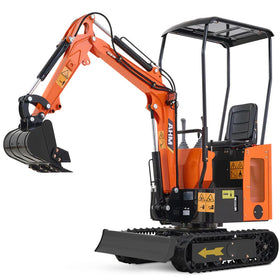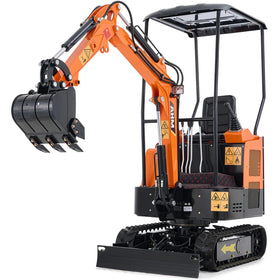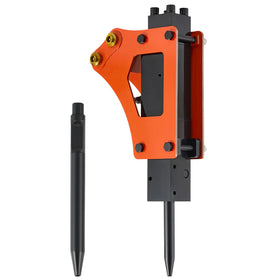Getting your mini excavator from point A to point B isn't just about hooking up a trailer and hitting the road. Learning how to transport a mini excavator involves making critical decisions about safety, legal compliance, and protecting your investment. Make the wrong call, and you're looking at hefty fines, damaged equipment, accidents, or worse.
Most mini excavator transport problems happen due to operators who didn't understand weight limits, chose the wrong trailer, or skipped safety steps. Whether you're moving a mini excavator across town or hauling one to another state, here’s everything you need to know!

Understanding Mini Excavator Transport Weight Requirements
Before you even think about loading your mini excavator, you need to understand the numbers that matter. The weight of your machine determines everything from trailer selection to whether you need a commercial driver's license.
Mini excavator transport starts with knowing your exact machine weight and trailer capacity. For example, the AHM AX-12B weighs 2,138 pounds, while the AY-25 weighs 5,401 pounds. Add attachments, and those numbers climb quickly.
So, make sure to calculate these essentials for safe transport:
- Machine Operating Weight: Base weight of your mini excavator
- Attachment Weights: Additional weight from accessories
- Trailer Weight: Empty trailer weight
- Safety Margin: 20-30% above total load weight
Explore more on why mini-excavator weight matters.
Going by these numbers, transporting an AX-16 (2,205 pounds) with attachments on a 2,000-pound trailer requires at least a 6,000-pound capacity trailer for proper safety margins.
DOT regulations require a minimum of four tie-downs for equipment over 10,000 pounds, and most AHM mini excavators fall under this threshold.
Different Methods to Transport a Mini Excavator
When it comes to how to transport mini excavator equipment, you have three main options. Each one may have distinct advantages and limitations based on your situation.
1. Transporting With a Trailer
Trailer transport is the most common way of moving a mini excavator because it offers the best combination of cost and flexibility. Using a trailer specifically designed for hauling heavy equipment provides the safest option for mini-excavator transport.
Advantages of Moving Your Mini-Excavator with a Trailer
Moving a mini excavator with a trailer is the most cost-effective for regular transport. You can move your equipment on your schedule, and you get complete control over loading and securing.
Set backs
Moving a mini excavator in a mini excavator requires investment in a trailer and a truck.
- You handle all legal compliance
- Bad weather could affect safety

2. Use Professional Transport Services
Professional equipment transport removes the complexity and liability of transportation from your shoulders. These professional services handle logistics, permitting, and specialized equipment for safe mini-excavator transport.
Advantages of Using Professional Transport Services for Moving a Mini Excavator
- It eliminates CDL requirements
- Professional drivers understand regulations
- You can get insurance coverage to protect the equipment
- It is ideal for long-distance moves
Set-backs:
- Higher per-trip costs
- Less scheduling flexibility
- Potential delays during peak seasons
Professional transport makes sense for expensive machines or multi-state moves.
4. Use Pickup Truck Transport
Some smaller mini excavators can be transported in pickup truck beds with proper equipment. Only consider this for micro excavators under 2,000 pounds. This method works only for the lightest compact excavators over short distances.
Advantages:
- Lowest equipment investment
- Works for emergency moves
Disadvantages:
- Extremely limited weight capacity
- Safety concerns with a high center of gravity
- Not suitable for most mini excavators
The Best Way to Transport Your Mini Excavator
The best way to transport a mini-excavator is to use a trailer. Transporting your mini excavator with a trailer offers the optimal balance of cost, safety, and flexibility. A quality trailer pays for itself after just a few uses while maintaining complete control over scheduling and equipment handling.
On the other hand, professional services charge $3-5 per mile, so moving an excavator 200 miles will cost $600-1,000 per trip. A suitable trailer and truck combination will cost around $15,000-25,000 initially, but don’t forget that afterwards you’ll be set to handle unlimited trips.

Key Safety Considerations for Transporting Mini Excavators
Securing the excavator properly will prevent equipment damage and DOT violations. Here are some critical safety steps you should keep in mind:
- Weight Distribution: Position the excavator slightly forward for 10-15% tongue weight
- Tie-Down Points: Use manufacturer-specified points on the excavator frame
- Chain Selection: Choose chains rated for 50% of the cargo weight per DOT regulations
- Ramp Safety: Use metal ramps with slip-resistant surfaces
- Pre-Transport Inspection: Check tires, lights, and safety equipment
Remember to always use ratchet binders for controlled tensioning when securing mini excavators to your trailer.
CDL Requirements and Legal Compliance
CDL requirements depend on your truck's GCWR and trailer GVWR ratings, not actual weight.
You need a Class A CDL if:
- Truck's GCWR exceeds 26,000 pounds AND
- Trailer's GVWR exceeds 10,000 pounds
Most contractors avoid CDL requirements by choosing the appropriate combinations. A 3/4-ton pickup with a 10,000-pound trailer stays under thresholds while safely hauling any AHM model. It’s important to remember that commercial use always triggers federal regulations.
Why Transportation Should Influence Your Mini Excavator Purchase
Smart buyers should always consider transport requirements before purchasing a new mini excavator. The difference between a 2,100-pound mini excavator and and 5,400-pound one transport complexity and costs will be substantial in the long run.
Transport-Friendly Features You Should Look For:
- Weight Class: Stay under 4,000 pounds for maximum options
- Compact Dimensions: Under 8 feet wide avoids oversized permits
- Removable Attachments: Quick-disconnect reduces transport weight
- Transport Locks: Boom and arm locks prevent movement

AHM Mini Excavators: Engineered for Easy Transport
AHM engineers designed excavators with transport in mind, and these machines solve many transport challenges through thoughtful engineering. Every model balances performance with transportability, includes multiple tie-down points, and has transport-friendly dimensions.
The AX-12B delivers the sweet spot at 2,138 pounds with 13.5 HP power and 69-inch dig depth. No special permits or CDL requirements needed.
The AX-16 series provides 23 HP performance at 2,227 pounds. The swing boom model (AX-16C) adds versatility while maintaining transport weight.
The AX-17 delivers maximum capability at 89-inch dig depth under 3,700 pounds. This represents the largest mini-excavator that most contractors can transport without special equipment.
The AY-25 series provides 25 HP Perkins diesel performance at 5,401 pounds, while still being easy to transport on standard trailers.
Making Mini Excavator Transport Work for Your Business
Understanding how to transport a mini excavator safely transforms from is less of a compliance requirement and more of a competitive advantage. Contractors who master efficient transport can serve wider geographic areas, respond faster to opportunities, and minimize equipment downtime.
Transport shouldn't be an afterthought in your decision to buy a mini excavator. Choose one engineered for the complete ownership experience – from job site performance to easy, legal transport that keeps your business moving forward.







